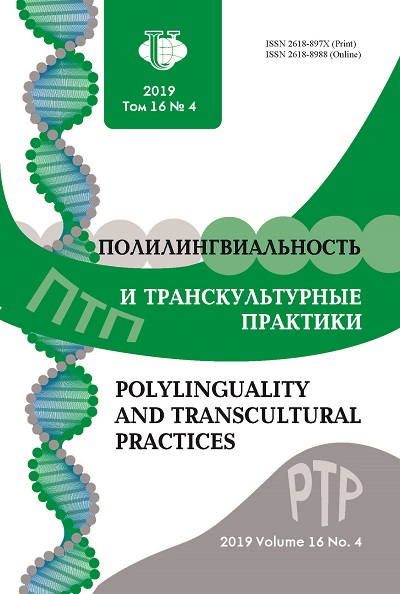Preface of Honorary Editor
- Authors: Kellman S.G1
-
Affiliations:
- University of Texas at San-Antonio
- Issue: Vol 16, No 4 (2019)
- Pages: 560-561
- Section: Translingual Imagination
- URL: https://journals.rudn.ru/polylinguality/article/view/22556
- ID: 22556
Cite item
Full Text
Abstract
Full Text
Literary translingualism - the practice of writing in more than one language or in a language other than one’s primary tongue - has ancient roots, stretching back millennia. However, it is only within the past two decades that it has received sustained scholarly attention. Though other terms such as exophone and plurlingue have been employed, the term translingual has gained wide currency among scholars throughout the world - in dissertations, monographs, journal articles, special issues of journals, and conferences. The language-switching of individual authors such as Beckett, Nabokov, and Isaak Dinesen had been analyzed, but, at least in the West, an attempt at a comprehensive study of the phenomenon of translingualism had to await Leonard Foster’s The Poet’s Tongues: Multilingualism in Literature (1970). However, the full wave of scholarship on the subject arrived with Elizabeth Klosty Beaujour’s Alien Tongues: Bilingual Russian Writers of the “First” Emigration (1989), Jacques Derrida’s Le monolinguisme de l’autre ou la prothèse d’origine (1996), John Skinner’s The Stepmother Tongue: An Introduction to New Anglophone Fiction (1998), Steven G. Kellman’s The Translingual Imagination (2000), and Doris Sommer’s Bilingual Aesthetics: A New Sentimental Education (2004). More recent contributions to the study of translingual literature include Brian Lennon’s In Babel’s Shadow: Multilingual Literatures, Monolingual States (2010) Yasemin Yildiz’s Beyond the Mother Tongue: The Postmonolingual Condition (2012), and Steven G. Kellman’s Nimble Tongues: Studies in Literary Translingualism (2020). The very first bibliography of translingual literature in several categories included in the special issue on literary translingualism of L2Journal (Steven G. Kellman and Natasha Lvovich, eds., L2Journal, 7:1 (2015)), testifies to the vitality of the field. Because poetry and fiction by translinguals, along with scholarship on their work, is proliferating, any such roster is of necessity provisional and incomplete. The essays I have assembled here - by authors representing a variety of backgrounds and specializations - provide a sample of the strength and range of contemporary scholarship on translingual literature. Adrian Wanner, a native of Switzerland, is a professor of Slavic Languages and Comparative Literature at Pennsylvania State University and both a scholar and translator of connections among Russian, German, French, Romanian, Ukrainian, and English. In Out of Russia: Fictions of a New Translingual Diaspora (2011), he examined the work, in English and German, of Russian émigrés to the United States and Germany. In the essay published here, an adaptation of part of his latest book The Bilingual Muse: Self-Translation Among Russian Poets (2020), Wanner analyzes the multilingual efforts of the precocious 19th-century poet Elizaveta Kul’man. Kellman S.G. Polylinguality and Transcultural Practices, 2019, 16 (4), 560-561 If he is remembered at all, Yone Noguchi (1875-1947) is usually identified as the father of Isamu Noguchi (1904-1988), the acclaimed Japanese American sculptor and landscape architect. However, as Elaine Wong notes, the elder Noguchi is considered the first native of Japan to have written an American novel in English. Wong, a native of Hong Kong who teaches at Trinity University in Texas and is active as a poet and a translator from Chinese, recovers Noguchi’s The American Diary of a Japanese Girl as a negotiation between languages, genders, and nationalities. In pursuit of his modernist cosmopolitan ideal, Eugene Jolas (1892-1952) mixed languages in his texts. Ania Spyra, who grew up speaking German and Polish in Upper Silesia in Southern Poland, examines how Jolas’s blend of English, French, German, and other languages enabled him to pursue a translingual and transnational identity. An associate professor of English at Butler University in Indiana, Spyra analyzes how Jolas’s multilingual texts represent an attempt to create the universal language of Atlantica, a “super-tongue for intercontinental expression”. By the middle of the 20th century, Hebrew had managed to triumph over Yiddish and other competitors as the unifying language of the Jewish people in Israel. However, as Melissa Weininger observes, recent trends in globalization, technology, and emigration have been creating a vibrant Israeli literature in languages other than Hebrew. Weininger, who teaches at Rice University and specializes in Hebrew and Yiddish with a particular interest in Diaspora Israeli literature and culture, examines how some texts written in Hebrew are assuming the coloration of other languages and how Israeli natives writing in English and German are challenging the geographical definition of Israeli literature. She concludes that: “Contemporary Israeli translingual, transcultural, and transnational literary movements have shifted the ground of home and homeland away from territory and toward culture”. Finally, Julie Hansen, a native of the United States who teaches at Uppsala University in Sweden, returns us to Russian literature with her nuanced analysis of the mixture of Russian, French, and other languages in Leo Tolstoy’s Voina i mir. A specialist in Russian literature and cultural memory, Hansen examines the reception and translation of the extended passages written in French in one of the most famous of “Russian” novels. She analyzes how “they draw the reader’s attention to language as a medium through depictions of code-switching and multilingual situations; metalinguistic commentary; biscriptuality; and code-mixing on the level of the text”.×
References
Supplementary files














